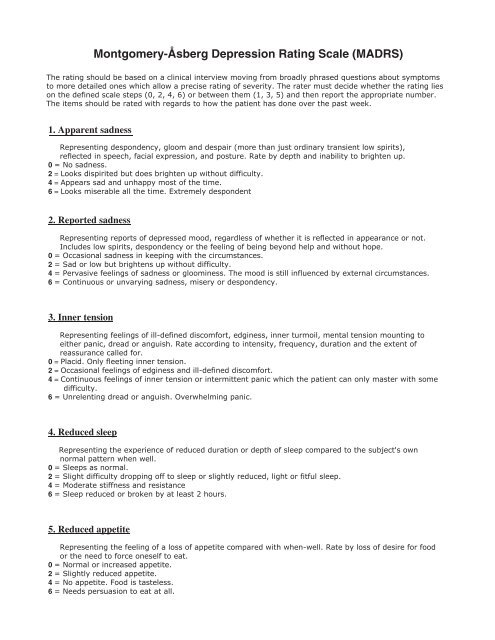Center for Epidemiologic Studies Depression Scale ... - myCME.com
Center for Epidemiologic Studies Depression Scale ... - myCME.com
Center for Epidemiologic Studies Depression Scale ... - myCME.com
Create successful ePaper yourself
Turn your PDF publications into a flip-book with our unique Google optimized e-Paper software.
Montgomery-Åsberg <strong>Depression</strong> Rating <strong>Scale</strong> (MADRS)<br />
The rating should be based on a clinical interview moving from broadly phrased questions about symptoms<br />
to more detailed ones which allow a precise rating of severity. The rater must decide whether the rating lies<br />
on the defined scale steps (0, 2, 4, 6) or between them (1, 3, 5) and then report the appropriate number.<br />
The items should be rated with regards to how the patient has done over the past week.<br />
1. Apparent sadness<br />
Representing despondency, gloom and despair (more than just ordinary transient low spirits),<br />
reflected in speech, facial expression, and posture. Rate by depth and inability to brighten up.<br />
0 = No sadness.<br />
2 = Looks dispirited but does brighten up without difficulty.<br />
4 = Appears sad and unhappy most of the time.<br />
6 = Looks miserable all the time. Extremely despondent<br />
2. Reported sadness<br />
Representing reports of depressed mood, regardless of whether it is reflected in appearance or not.<br />
Includes low spirits, despondency or the feeling of being beyond help and without hope.<br />
0 = Occasional sadness in keeping with the circumstances.<br />
2 = Sad or low but brightens up without difficulty.<br />
4 = Pervasive feelings of sadness or gloominess. The mood is still influenced by external circumstances.<br />
6 = Continuous or unvarying sadness, misery or despondency.<br />
3. Inner tension<br />
Representing feelings of ill-defined dis<strong>com</strong><strong>for</strong>t, edginess, inner turmoil, mental tension mounting to<br />
either panic, dread or anguish. Rate according to intensity, frequency, duration and the extent of<br />
reassurance called <strong>for</strong>.<br />
0 = Placid. Only fleeting inner tension.<br />
2 = Occasional feelings of edginess and ill-defined dis<strong>com</strong><strong>for</strong>t.<br />
4 = Continuous feelings of inner tension or intermittent panic which the patient can only master with some<br />
difficulty.<br />
6 = Unrelenting dread or anguish. Overwhelming panic.<br />
4. Reduced sleep<br />
Representing the experience of reduced duration or depth of sleep <strong>com</strong>pared to the subject's own<br />
normal pattern when well.<br />
0 = Sleeps as normal.<br />
2 = Slight difficulty dropping off to sleep or slightly reduced, light or fitful sleep.<br />
4 = Moderate stiffness and resistance<br />
6 = Sleep reduced or broken by at least 2 hours.<br />
5. Reduced appetite<br />
Representing the feeling of a loss of appetite <strong>com</strong>pared with when-well. Rate by loss of desire <strong>for</strong> food<br />
or the need to <strong>for</strong>ce oneself to eat.<br />
0 = Normal or increased appetite.<br />
2 = Slightly reduced appetite.<br />
4 = No appetite. Food is tasteless.<br />
6 = Needs persuasion to eat at all.
















